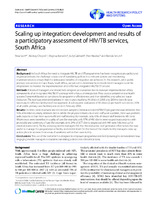| dc.contributor.author | Scott, Vera | |
| dc.contributor.author | Chopra, Mickey | |
| dc.contributor.author | Azevedo, Virginia | |
| dc.contributor.author | Caldwell, Judy | |
| dc.contributor.author | Naidoo, Pren | |
| dc.contributor.author | Smuts, Brenda | |
| dc.date.accessioned | 2010-11-24T14:29:04Z | |
| dc.date.available | 2010-11-24T14:29:04Z | |
| dc.date.issued | 2010 | |
| dc.identifier.citation | Scott V., et al. (2010). Scaling up integration: Development and results of a participatory assessment of HIV/TB services, South Africa. Health Research Policy and Systems, 8:23. | en_US |
| dc.identifier.uri | http://hdl.handle.net/10566/173 | |
| dc.description.abstract | BACKGROUND: In South Africa the need to integrate HIV, TB and STI programmes has been recognised at a policy and
organisation level; the challenge is now one of translating policies into relevant actions and monitoring
implementation to ensure that the anticipated benefits of integration are achieved. In this research, set in public
primary care services in Cape Town, South Africa, we set out to determine how middle level managers could be
empowered to monitor the implementation of an effective, integrated HIV/TB/STI service.
METHODS: A team of managers and researchers designed an evaluation tool to measure implementation of key
components of an integrated HIV/TB/STI package with a focus on integration. They used a comprehensive health
systems framework based on conditions for programme effectiveness and then identified and collected tracer
indicators. The tool was extensively piloted in two rounds involving 49 clinics in 2003 and 2004 to identify data
necessary for effective facility-level management. A subsequent evaluation of 16 clinics (2 per health sub district, 12%
of all public primary care facilities) was done in February 2006.
RESULTS: 16 clinics were reviewed and 635 records sampled. Client access to HIV/TB/STI programmes was limited in that
50% of facilities routinely deferred clients. Whilst the physical infrastructure and staff were available, there was problem
with capacity in that there was insufficient staff training (for example, only 40% of clinical staff trained in HIV care).
Weaknesses were identified in quality of care (for example, only 57% of HIV clients were staged in accordance with
protocols) and continuity of care (for example, only 24% of VCT clients diagnosed with HIV were followed up for
medical assessment). Facility and programme managers felt that the evaluation tool generated information that was
useful to manage the programmes at facility and district level. On the basis of the results facility managers drew up
action plans to address three areas of weakness within their own facility.
CONCLUSIONS: This use of the tool which is designed to empower programme and facility managers demonstrates how
engaging middle managers is crucial in translating policies into relevant actions. | en_US |
| dc.language.iso | en | en_US |
| dc.publisher | BioMed Central Ltd | en_US |
| dc.rights | © 2010 Scott et al; licensee BioMed Central Ltd.
This is an Open Access article distributed under the terms of the Creative Commons Attribution License (http://creativecommons.org/licenses/by/2.0), which permits unrestricted use, distribution, and reproduction in any medium, provided the original work is properly cited. | |
| dc.source.uri | http://dx.doi.org/10.1186/1478-4505-8-23 | |
| dc.subject | Programme evaluation | en_US |
| dc.subject | HIV/AIDS | en_US |
| dc.subject | Tuberculosis | en_US |
| dc.subject | Sexually transmitted infections (STIs) | en_US |
| dc.subject | Integration | en_US |
| dc.subject | South Africa | en_US |
| dc.subject | Healthcare | en_US |
| dc.title | Scaling up integration: Development and results of a participatory assessment of HIV/TB services, South Africa | en_US |
| dc.type | Article | en_US |
| dc.privacy.showsubmitter | false | |
| dc.status.ispeerreviewed | true | |

